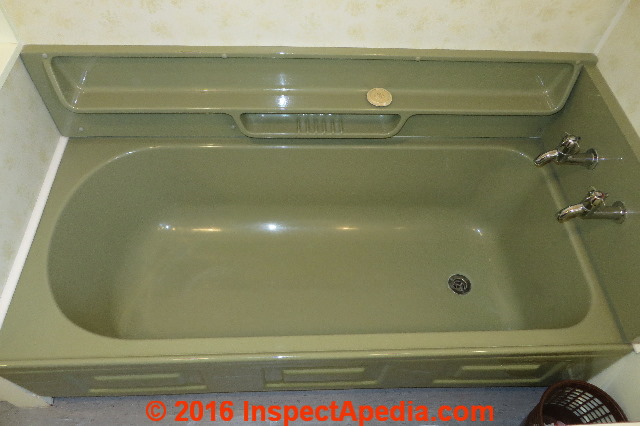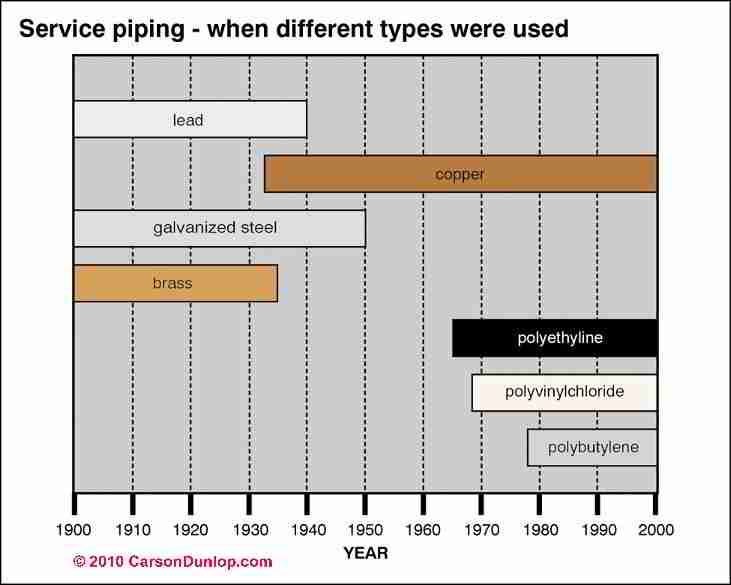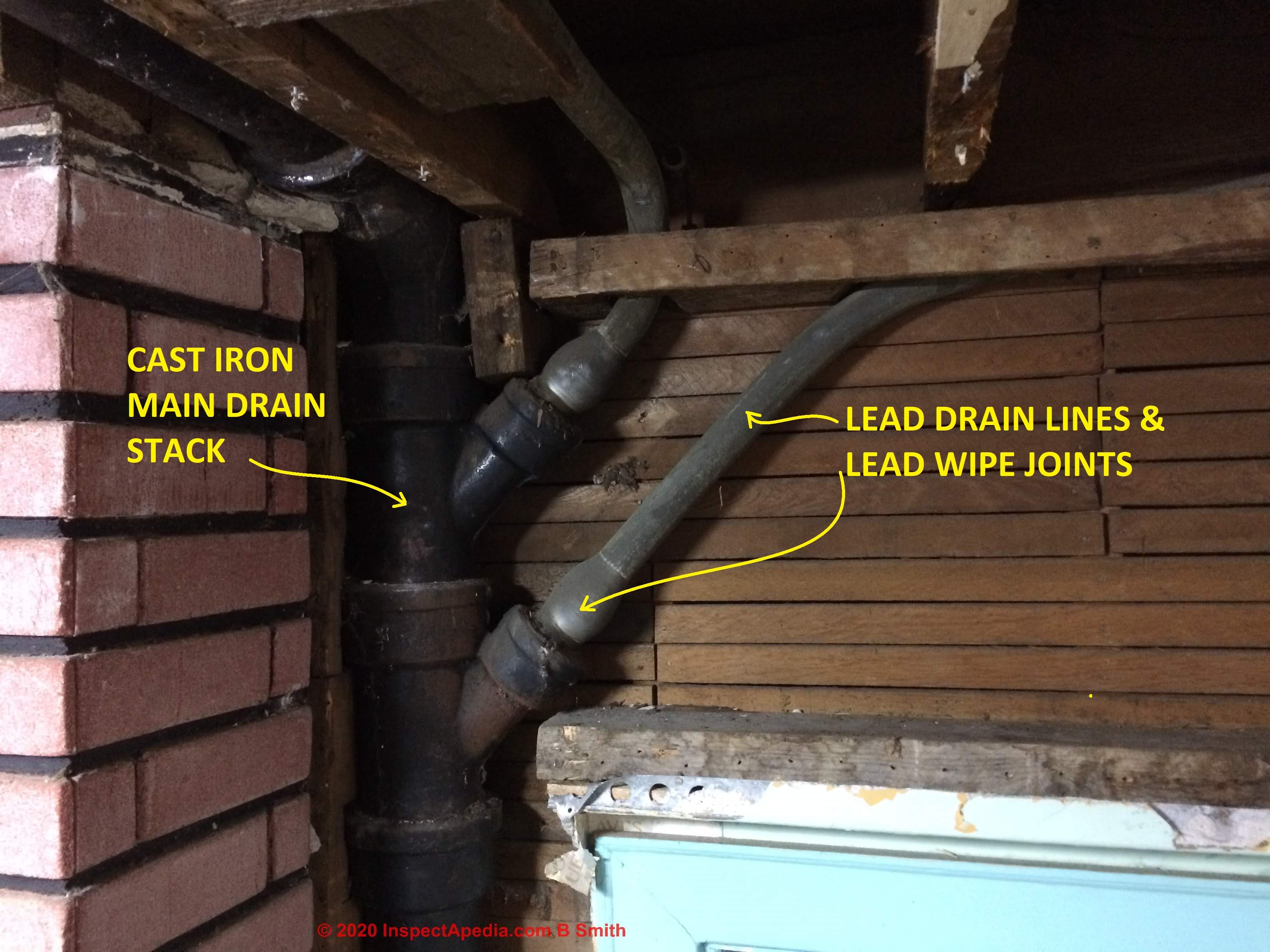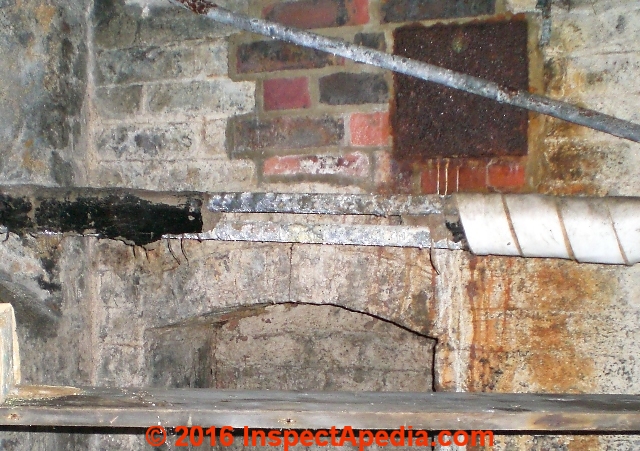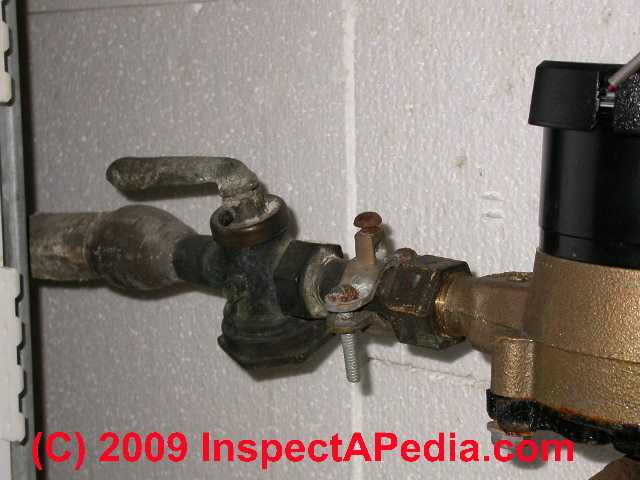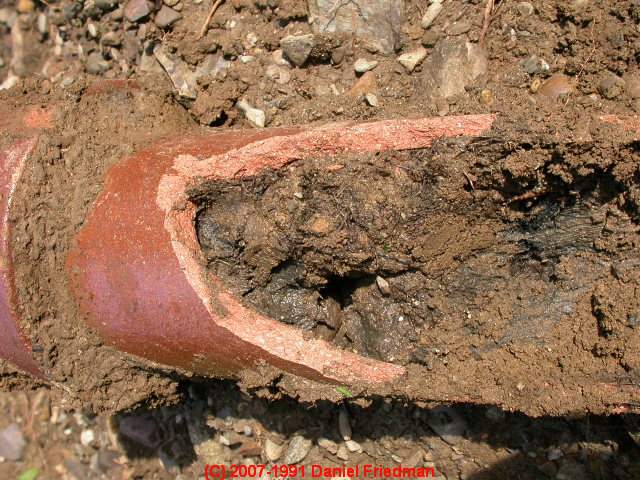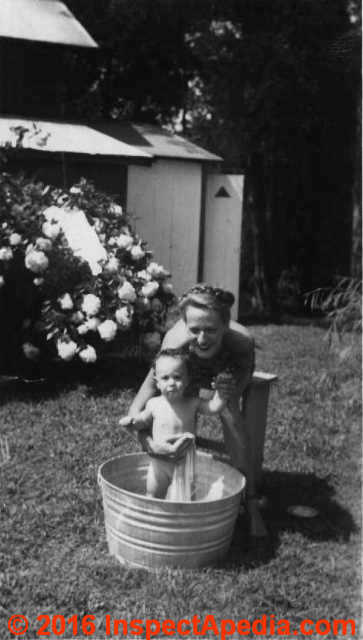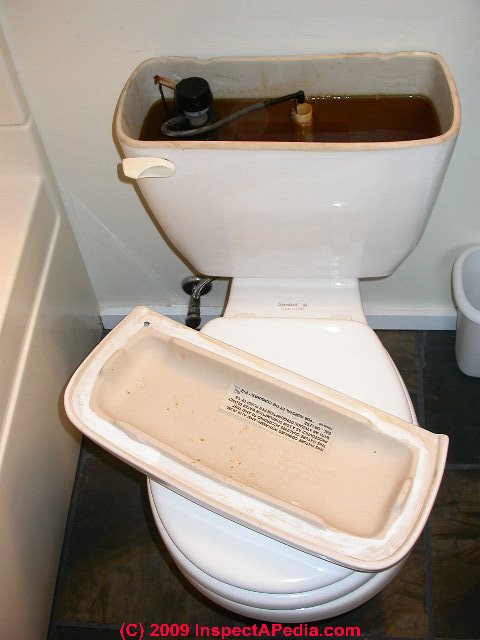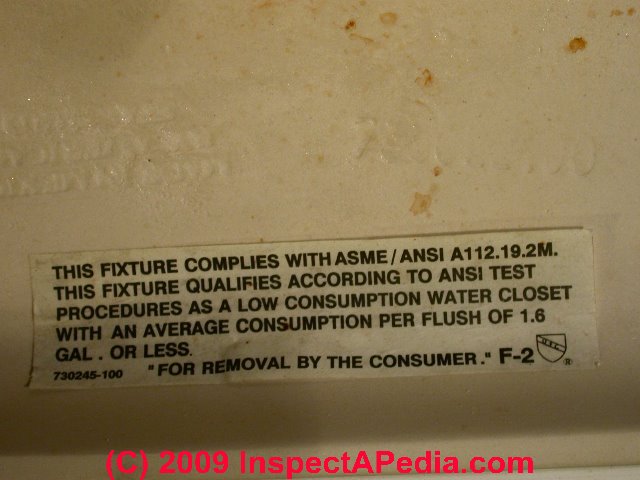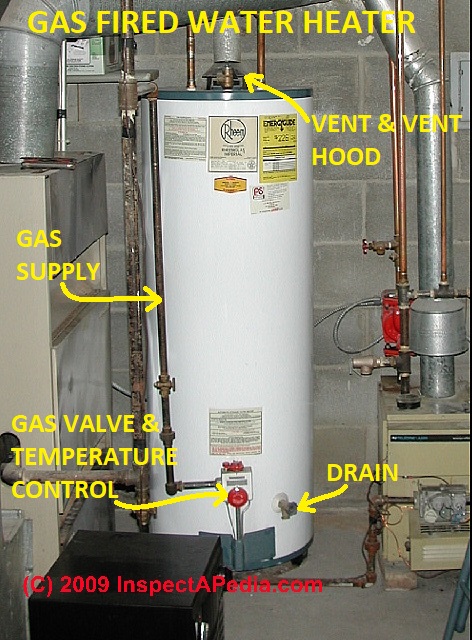 Determine The Age of Building Plumbing Piping,
Determine The Age of Building Plumbing Piping,
Drains, Materials & Fixtures
- POST a QUESTION or COMMENT about the age and history of plumbing materials and fixtures in buildings
Age of plumbing materials:
Here we provide a photo guide to determining the age of a building or its plumbing system, piping, and fixtures by examination of visual clues.
The age of a building can be determined quite accurately by documentation, but when documents are not readily available, visual clues such as those available during a professional home inspection can still determine when a house was built by examining its components, building materials, even nails, fasteners, and types of saw cuts on lumber.
Here we list some helpful clues to answer the question "how old is the house?" and we provide photographs of key visual clues useful for determining the age of a building.
InspectAPedia tolerates no conflicts of interest. We have no relationship with advertisers, products, or services discussed at this website.
- Daniel Friedman, Publisher/Editor/Author - See WHO ARE WE?
Guide to the Age of Plumbing Materials & Plumbing Fixtures as Indicators of Building Age
Shown here: a photograph of an active gaslight found in a 1900 home in New York.
[Click to enlarge any image]
Often old gas lines have been disconnected entirely and sometimes they have been re-used to route electrical wiring to new light fixtures or to gaslight fixtures which have been converted to electric.
Don't assume that an old gas fixture or valve on a wall or found in a fireplace are inactive. We turned-on and lit this fixture which gave a bright surprise to everyone.
Article Contents
Bathubs Help Determine the Age of a Building
While nearly any home inspected in North America will have an indoor bathroom at present, in 1921 only one percent of homes had an indoor bathroom.

- Claw-foot cast iron bath tubs - 1835 - 1903. Our photos (above and below) show an antique cast iron claw foot tub that we salvaged, cleaned, and re-installed by the author (DF) during restoration of an 1860's house in Wappingers Falls, NY.
Free-standing cast iron or replica claw foot bath tubs and similar freestanding tubs without the feet are still available, as we show in this photo of a modern free-standing bathtub.
In 1883 Standard Manufacturing and Kohler began producing cast iron bath tubs in the U.S., initially described for use as a hog scalder or horse trough (but suitable for bathing). Wikipedia cites five styles of claw-foot bathtubs:- Classic Roll Rim, Roll Top, or Flat Rim tubs
- Slipper tubs - one end is raised and sloped
- Double Slipper Tubs - both ends of the bathtub are raised and sloped
- Double Ended Tubs - where both ends of the tub are rounded.
- Pedestal Tub - Pedestal tubs, unlike the styles above, do not have claw feet but rest on a pedestal that is in floor contact all around the tub - dates to Crete, 1000 BC.
- Porcelain covered cast iron bathroom tubs - ca 1905 to present.
- Colored porcelain bathroom fixtures - 1928 (Crane Mfg.) to present
- Porcelain coated pressed-steel bath tubs - ca 1960 to present
- Fiberglass bath tubs - ca 1975 to present
- Solid acrylic bath tubs - ca 1980 to present, vacuum molded from sheets of acrylic reinforced with fiberglass;
- Bath tub re-lining processes - e.g. Re-Bath, using a 1/4" thick polymer-cover that is dropped into and re-covers an existing tub.
Re-Bath™ stocks 1000 tub shapes and can fit nearly every tub shape made in the U.S. since 1920 with a new liner. Because the Re-bath liner is a molded copy of the original bath tub (now hidden below the liner) you might have difficulty determining when this product has been installed. There are several clues, but the simplest is to notice the Re-Bath name on the tub overflow control [image file]
Another bath tub rejuvenating option is bath tub refinishing using a combination of tub scratch filler, surface etching, a primer, and an acrylic urethane top coat, or an epoxy tub paint.
The really ugly green 1960's vintage plastic bath tub shown below is installed in home in Christchurch, New Zealand (Photo 2014 -df).
The green of this tub was such as perfect match for a combination porcelain and plastic McSkimming toilet that we speculated that the tub might have been produced by McSkimming too.
See LOW COST TOILETS. McSkimming brick & ceramics works produced clay toilets and other products in New Zealand from 1882 until the 1980's.
Age of Supply & Drain Piping: Chart of Dates When Different Types of Plumbing Piping Were Used in Homes
Above, our chart of plumbing types and years of use is provided courtesy of Carson Dunlop. The chart shows that lead water service piping was in common use in North America from 1900 to 1940. During that same period Galvanized steel pipes were also in use, extending up to about 1950, while brass water supply piping also was in use as early as 1900 or even the later 1800's, but fell from common use in new construction by 1935.
Copper water supply pipes came into widespread use in 1935 and extend to the present, while plastic water supply piping (polyethylene, PVC, etc. were not in common use before 1970. PEX plastic supply piping for water distribution and in some cases for heating water distribution has been in wide use since the 1990's.
Prior to 1800 in North America pipes were made of wood, from hollow trees or carved from solid wood hewn from trees. Cast iron piping was not produced in the U.S. before ca. 1825.
Plumbing fixtures and piping materials offer considerable age in dating a building, including easy clues such as the presence of a date of manufacture stamped into many toilet tanks to the periods of use of types of water supply piping (lead, galvanized steel, black iron pipe, copper, plastic piping) and building drain piping (lead, cast iron, copper, plastic, clay).
Often on older buildings multiple types of piping will be present as repairs and changes have been made in the building plumbing system.
Below: lead building drain lines connected to a cast iron main drain stack.
And determining just what the piping materials are can be tricky.
Below our photo of old water or heating pipes (follow the pipes to see their connections) illustrates the difficulty of pipe material identification by simple inspection.
One may need to scrape a bit at the pipe surface to distinguish between brass and copper, or use a magnet to identify steel.
Watch out: while the black tarry debris on the pipes at left in our photo may be a bituminous compound, both that mastic and the white debris on the pipes may contain asbestos. Handle inspection and sampling with appropriate care.
Below we see lead water supply entry main piping.
Cast iron piping used for in-building drain piping as well as sewer lines is shown
at FIND the MAIN BUILDING DRAIN, and
at How to Use a Power Snake on Building Drains you can see a common splice-in of ABS plastic drain piping into an existing cast iron sewer line.
Clay drainfield piping or "drain tiles" (Mission Band-Seal Vitrified Clay Pipe) is shown in fragments [photo below] is discussed in our article on sewer line replacement
at DETERMINE NEED for DRAIN LINE REPLACEMENT.
We also provide this photo of another type of hubless octagonal clay sewer and septic piping [shown below] that was often used in drainfields as disjointed sections.
Lead water entry piping (see LEAD PIPES in BUILDINGS) connecting a building to the street water main is shown in our photo (left) where you can also see gray-painted cast iron drain piping.
See LEAD IN DRINKING WATER, HOW to REDUCE.
Orangeburg drain & septic field piping, most widely used in drain piping and septic fields, was made of ground wood fibers bound with an adhesive mastic (coal tar), typically looking like black"tarred" piping.
Details about orangeburg pipe are
at ORANGEBURG PIPE - first used in the U.S. in Boston in 1865 but was not likely to be found in a building area drain, footing drain, or septic drainfield before the late 1940's and then through the 1960's to early 1970's.
Details about all types of building supply and drain piping materials and heating pipes are found
at PIPING in BUILDINGS, CLOGS, LEAKS, TYPES.
Sinks as Indicators of Building Age
Here we illustrate the wide variety of materials used to construct kitchen, laundry, and bathroom sinks and we discuss the typical age of each sink type.
The cast concrete laundry sink with a hand-wringer for clothing shown above is installed at a national park building in Akaroa, New Zealand and is still in active use. In North America cast concrete sinks have been in use for more than 100 years.
In the U.S., Erwin O. Warndorff, assigning to the Concrete Fixtures Company, patented an improved metal rim for concrete laundry tubs in 1925.
The wide use of these fixtures led to a plethora of patented improvements in sink production, features, and components. (Stoddard 1933). The sink shown above has a metal rim.
As with toilets and bath tubs, often a look at the materials and style of sinks used in a bath, kitchen, or in a laundry area can give clues about the probable age of the building as well as of the plumbing fixture.
Lucas (2012) traces the history of kitchen sinks in Canada and illustrates various of these fixtures beginning with galvanized wash tubs used in homes where plumbing was not yet installed.
Below: the author Daniel F. in a galvanized washtub, being bathed by his mom, Teal, ca: 1944, Dunnsville, Virginia.
Please see SINK TYPES & MATERIALS for our catalog of types of sinks and sink materials, uses, ages, history.
Also see PLUMBING FIXTURES, KITCHEN, BATH, a guide to choosing & installing plumbing fixtures for kitchens and bathrooms.How to Use the Date Stamp in Toilets as A Way to Date the Age of A Building

Does the toilet date stamp tell the age of a building? Well not exactly, but lots of toilets include a date stamped or embossed into the interior of the toilet tank, often in the toilet tank lid, as we show in our photo below.
That embossed date stamp indicates the year of manufacture of the toilet. If the toilet is original to the home that may give us a clue about the age of the building.
Of course if the toilet has been installed during a plumbing update it will be newer than the home. In our example the example toilet was manufactured 30 July 1994 but the toilet was installed in a home built in 1920.
Sir John Harington is credited with invention of the first flush toilet (for Queen Elizabeth I in 1596), but the flush toilets were not produced in volume before the water closet designed by Alexander Cummings - 1775.
Indoor toilets using a high wall-mounted local water reservoir (and a pull chain flush valve) have been in use in the U.S. since around 1890. An early wall-tank flush toilet is shown in the sketch at left.
Flush valve toilets that operated by (high) municipal water pressure (and excluded a local water reservoir tank) have been in common use in the U.S. since around 1920.
Modern tank type toilets that incorporate their water reservoir right atop the bowl have been in common use in the U.S. since around 1940.
Reader Kathy Bohon points out that the date stamp on a toilet tank or lid is a useful age indicator provided that the building plumbing system has not been renovated.
Of course since the toilet will have been manufactured before it was installed, or if the toilet was re-used from another structure, in either case it's date will be a bit earlier than that of the building.
History and Dating of Low Flush Toilets
Low-flush toilets that reduce the quantity of water used began in popular use in the U.S. by 1980, but you may need to look closely inside the toilet tank to identify some models.
Look for a label (photos shown just above) in the tank lid stating "This toilet complies with ASME / ANSI A112.19.2M.
This fixture qualifies according to ANSI test procedures as a low consumption water closet with an average consumption per flush of 1.8 gal or less."
As this tag may have been removed, also look on the toilet tank or base for a low flush designation included in the porcelain coating such as we show in our photos.
Simple plastic retrofit internal reservoirs allowed toilet manufacturers to leave the toilet exterior size and shape intact even when going to a low-flush water savings design.
At TOILET OVERFLOW EMERGENCY you can see one of these toilet models.
Also see TOILET TYPES, CONTROLS, PARTS
Can the Age of a Water Heater Tell Building Age?
How can we determine the age of a residential water heater? By looking at and decoding data on the water heater's label.
It would be unusual to find an original water heater in a building built before 1970 in the U.S. so don't assume that the water heater age is the building age for an older home.
Nearly all modern water heaters, electric, oil fired, or gas fired, include data tags and stickers that indicate the year and month of manufacture of the water heater.
That doesn't tell you exactly when a water heater was installed in a particular building but it does indicate the age of the water heater itself.
However most manufacturers encode the year and month of manufacture of their water heater in the product's serial number so that the water heater age is not immediately obvious, but it can be decoded. .
Our photo (left) shows a gas-fired Rheem™ water heater.
The label containing the unit's serial number is probably at the water heater top left. The label above the gas control at the water heater bottom typically contains water heater lighting instructions.
For details about determining the age of water heaters,
see AGE of WATER HEATERS where we include a chart which Scott LeMarr has generously shared.
For the most complete and very detailed HVAC and water heating equipment data tag and age decoding information anywhere, Alan Carson and Bob Dunlop, Carson Dunlop, Associates, Toronto, offer Carson Dunlop Weldon & Associates Technical Reference Guide to manufacturer's model and serial number information for heating and cooling equipment ($69.00 U.S.).
At Water Heater Life Expectancy Comparisons we list factors that determine the life expectancy of a water heater.
...
Reader Comments, Questions & Answers About The Article Above
Below you will find questions and answers previously posted on this page at its page bottom reader comment box.
Reader Q&A - also see RECOMMENDED ARTICLES & FAQs
Question:
Jan 28, 2012) jerry goggin said:
my neighbor hood in tucson abounds in plumbing failures please advise have one right now under driveway
Reply:
Jerry I suggest hiring a plumber who can use a camera to scope your drains to see their condition and give you a report on what's needed. That way you can see for yourself what's going on.
Question:
Hello
I'm looking for some information on
"How to inspect the condition of the bathroom pipes from the external access points"
My house was built in the 1950's.
These pipes can be access from outside the building as they are channeled into a
drain.
My email address is glidj@hotmail.com
Thank you.
Reply:
Jenny the advice I give above to Jerry will help you out too.
...
Continue reading at CESSPOOL AGE ESTIMATION or select a topic from the closely-related articles below, or see the complete ARTICLE INDEX.
Or see these
Recommended Articles
- AGE of a BUILDING
- AGE of AIR CONDITIONERS & HEAT PUMPS
- AGE of HEATERS, BOILERS, FURNACES
- AGE of PLUMBING MATERIALS & FIXTURES
- ARCHITECTURE & BUILDING COMPONENT ID
- BRASS WATER PIPES
- CRANE PLUMBING & HEATING CATALOG 1950 [PDF]
- GALVANIZED STEEL WATER PIPING
- LEAD PIPES in BUILDINGS
- TRANSITE PIPE WATER SUPPLY PIPING
Suggested citation for this web page
AGE of PLUMBING MATERIALS & FIXTURES at InspectApedia.com - online encyclopedia of building & environmental inspection, testing, diagnosis, repair, & problem prevention advice.
Or see this
INDEX to RELATED ARTICLES: ARTICLE I NDEX to PLUMBING SYSTEMS
Or use the SEARCH BOX found below to Ask a Question or Search InspectApedia
Ask a Question or Search InspectApedia
Try the search box just below, or if you prefer, post a question or comment in the Comments box below and we will respond promptly.
Search the InspectApedia website
Note: appearance of your Comment below may be delayed: if your comment contains an image, photograph, web link, or text that looks to the software as if it might be a web link, your posting will appear after it has been approved by a moderator. Apologies for the delay.
Only one image can be added per comment but you can post as many comments, and therefore images, as you like.
You will not receive a notification when a response to your question has been posted.
Please bookmark this page to make it easy for you to check back for our response.
IF above you see "Comment Form is loading comments..." then COMMENT BOX - countable.ca / bawkbox.com IS NOT WORKING.
In any case you are welcome to send an email directly to us at InspectApedia.com at editor@inspectApedia.com
We'll reply to you directly. Please help us help you by noting, in your email, the URL of the InspectApedia page where you wanted to comment.
Citations & References
In addition to any citations in the article above, a full list is available on request.
- Mark Cramer Inspection Services Mark Cramer, Tampa Florida, Mr. Cramer is a past president of ASHI, the American Society of Home Inspectors and is a Florida home inspector and home inspection educator. Mr. Cramer serves on the ASHI Home Inspection Standards. Contact Mark Cramer at: 727-595-4211 mark@BestTampaInspector.com
- John Cranor [Website: /www.house-whisperer.com ] is an ASHI member and a home inspector (The House Whisperer) is located in Glen Allen, VA 23060. He is also a contributor to InspectApedia.com in several technical areas such as plumbing and appliances (dryer vents). Contact Mr. Cranor at 804-873-8534 or by Email: johncranor@verizon.net
- Thanks to reader Kathy Bohon for suggesting additional details about determining the age of a home by looking for a date stamp in the toilet tank or lid. Ms. Bohon points out that if a building's plumbing system has not been renovated, the toilet date stamp can be a reliable indicator of approximate building age. (7/30/2009).
- Carson Dunlop, Associates, Toronto, have provided us with (and we recommend) Carson Dunlop Weldon & Associates'Technical Reference Guide to manufacturer's model and serial number information for heating and cooling equipment ($69.00 U.S.). Technical Reference Guide, Carson Dunlop Weldon & Associates, Ltd., 120 Carlton St. Suite 407, Toronto, Ontario, M5A 4K2 Canada, ISBN 1-895585-90-2 165pp.
- Re-Bath, tub lining products is a bath tub relining manufacturer and distributor located in Tempe, Arizona - see rebath.com
- Scott C. LeMarr has provided his file of keys to decode Furnace and Water Heater Age from the data provided on the manufacturer's equipment labels. Mr. LeMarr is a professional home inspector, Certified Professional Inspector/President, MASTER Indoor Environmental Specialist (MIES). Vice President of Wisconsin NACHI. He and his company, Honest Home Inspections [ Website: www.HonestHomeInspections.com ], LLC. can be reached at 262-424-5587 or by email to scott@honesthomeinspections.com
- Sewer History - great resource for the history of sewer piping - see http://www.sewerhistory.org
- Wikipedia entry on bathtubs: see http://en.wikipedia.org/wiki/Bathtub
- In addition to citations & references found in this article, see the research citations given at the end of the related articles found at our suggested
CONTINUE READING or RECOMMENDED ARTICLES.
- Carson, Dunlop & Associates Ltd., 120 Carlton Street Suite 407, Toronto ON M5A 4K2. Tel: (416) 964-9415 1-800-268-7070 Email: info@carsondunlop.com. Alan Carson is a past president of ASHI, the American Society of Home Inspectors.
Thanks to Alan Carson and Bob Dunlop, for permission for InspectAPedia to use text excerpts from The HOME REFERENCE BOOK - the Encyclopedia of Homes and to use illustrations from The ILLUSTRATED HOME .
Carson Dunlop Associates provides extensive home inspection education and report writing material. In gratitude we provide links to tsome Carson Dunlop Associates products and services.




